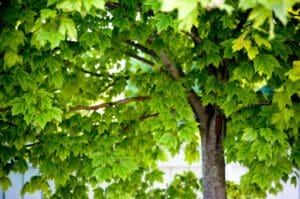Allergic Living’s handy region-by-region field guide to Canada and common trees that release pollen grains.
For the U.S. field guide, see America’s Trees of Allergies.
We can blame the deciduous trees’ attempts at procreation for our watery, red-eyed snuffling and other springtime rhinitis symptoms. Catkins, which often appear as elaborate cones or buds, are a tree’s reproductive organs, and they bloom before the leaves bud. Male catkins will release literally millions of pollen grains into the air in an attempt to find a female catkin match.
Dr. Wilf Nicholls, director of the Memorial University of Newfoundland Botanical Garden, explains that wind pollination is “super inefficient” because only a fraction of the huge amounts of tiny pollen grains the tree churns out will arrive at their intended destination, the female catkin. Instead, great quantities of them will be inhaled into noses and throats and set off reactions in the tree allergic.
It’s an unlucky break that most deciduous trees in northern climes are wind-pollinated. Birch, elm, maple, oak and poplar are some of the most allergenic trees across Canada and the northern United States. But where you are, the month and the weather all influence the onset of symptoms.
West Coast
On the foliage-rich west coast, red alder is public enemy number one. Robert Guy, head of forest sciences at the University of British Columbia, says much of the forest surrounding coastal towns and cities is full of red alder. Depending on the weather, these trees can pollinate as early as mid-February, or as late as the end of March, and they spread pollen for about three weeks.
Vancouver allergist Dr. Donald Stark says red alder is particularly insidious because it produces a ton of pollen grains; it often has the highest pollen count of any plant on the coast. People allergic to it may also react to birch trees, which pollinate about a month after alders, prolonging the misery.
Stark identifies the Garry oak as another culprit on the west coast.
In most of Canada, ragweed is the worst offender for triggering hay fever, followed by grass, then trees. Stark says the west coast is the exception: here, trees pack the hardest punch.
The Prairies
Those of us living on the continent’s northern plains have willow, birch and poplars (cottonwood and aspen) to blame for the first bout of red eyes and respiratory distress. Pollination time on the Prairies is heavily influenced by the weather, and these trees typically bloom in late April or early May.
The paper birch is so ubiquitous, it’s “almost synonymous with Canada,” Guy says. Civic governments plant paper birch, ash and elm trees in many Prairie cities. Oak is found in forested areas. Poplar, a widespread tree on the plains, is one of the first to spread its pollen grains and seed.
Not as numerous but also allergy-causing to some is the Russian olive. “They’re popular in the Prairies because there’s not much you can grow there,” Vancouverite Guy says with a chuckle.
Central-East Region
Allergy sufferers in Southern Ontario, Quebec, and the northeastern U.S. have a bevy of pollinating trees to avoid. Ottawa allergist Dr. Mortimer Katz says birch, elm, maple, oak and poplar are some of the worst offenders. More bad news: if you react to one of those trees, you’re more likely to “cross-react” and develop symptoms to some of the others.
An area stretching up the northeastern U.S. into southern Ontario which includes Pittsburgh and Toronto is particularly bad, thanks to prolific grasses, trees and ragweed. Katz dubs the Ottawa Valley the “allergy capital of the world,” adding that “almost everybody who comes to Ottawa says their allergies are worse here.”
Trees can start causing trouble in central Canada as early as March and as late as May.
The Atlantic
East coasters are blessed with more coniferous (and mostly non-allergenic) trees than the rest of the country, but poplars, maples, oaks and birch trees are also present. Maritime trees usually start churning out pollen in late winter to early spring, Nicholls says.
Newfoundlanders, however, may not start sneezing until May because, as Nicholls notes, it “warms up really slowly. The longer it’s frosty and cold, the slower those catkins will emerge and release pollen.” Katz says fresh air blowing off the ocean also keeps some east coasters’ allergies at bay.
Turning off the tap
Why are some trees more irritating than others? Stark says it depends on the amount of wind-blown pollen a tree produces, as more pollen grains mean more reactivity, as well as the physical properties of pollen grains, such as size, coating and weight (lighter seeds are easily carried on the wind). Trees that rely on insects or birds to transfer pollen from male to female catkins, such as cherry and Pacific Dogwood, have seeds with a waxy coating, which helps stop reactive proteins from reaching the immune system and firing it up.
The telltale sign a patient is allergic to trees is the timing of symptoms, says Dr. Eric Leith, chair of the Canadian Allergy, Asthma and Immunology Foundation, and an allergist in Toronto and Oakville. “If you’re coughing and rubbing your eyes after the snow melts, trees are a likely cause,” he says. A skin-prick test or an allergy blood test can confirm the diagnosis.
Relief from tree pollen’s toll is available: there are reliable, non-sedating antihistamines and nasal-steroid sprays, or ask an allergist if you’re a candidate for immunotherapy (allergy shots). Those who sneeze at trees should also try to keep the pollen out of their homes by keeping the windows shut in spring. Remember that the lovely breeze has a role in the great pollen explosion.
Reprinted from Allergic Living magazine. © Copyright AGW Publishing Inc.
To order a subscription, click here.
See Also:
- Outdoor Allergies Resource Hub – a compilation of our best.
- Sneeze-free Garden – create the perfect low-allergen garden.
- Trees that Make You Sneeze
- Stinging Insect Allergies – when is it a serious reaction?







